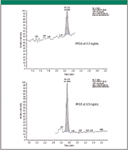Quantitative LC–MS Analysis of Pefluorochemicals
The Application Notebook
This application note describes a fast and sensitive LC-MS method using a Hypersil GOLDâ„¢ column on a Thermo Scientific LC-MS system for the quantitative analysis of two widespread PFCs, perfluorooctanoic acid (PFOA) and perfluorooctansulfonate (PFOS).
This application note describes a fast and sensitive LC-MS method using a Hypersil GOLD™ column on a Thermo Scientific LC-MS system for the quantitative analysis of two widespread PFCs, perfluorooctanoic acid (PFOA) and perfluorooctansulfonate (PFOS).
Perfluorochemicals (PFCs) are used in the manufacture of many industrial products such as surfactants, polymers and plastic additives. Monitoring their environmental accumulation is of importance due to their widespread use and high chemical stability. Of special concern is the accumulation in various biological species, including man. Although the toxicological effects are not well understood it is clear that PFCs may impact on the peroxisome proliferation, membrane function and the reproductive system. It is therefore essential to have sensitive methods in place to allow detection and quantitation of traces of PFCs. The Hypersil GOLD™ column, based on ultra-pure silica and state-of-the-art bonding, generates highly efficient and symmetrical peaks allowing for good peak height and signal-to-noise ratios for the PFCs.

Figure 1
Experimental Conditions
LC/ESI/MS
LC System: Thermo Scientific Rheos 2000 pump
Column: Hypersil GOLD 3 μm, 50 × 2.1 mm
Part Number: 25003-052130
Mobile Phase: A: 2mM NH4Ac in water/methanol (95:5)
B: 2mM NH4Ac in methanol
Gradient: Time (min) ............. %B
0.0 ...................................... 55
3.0 ...................................... 85
3.1 ...................................... 95
4.0 ...................................... 55
5.0 ...................................... 55
Flow Rate: 0.3 mL/min
Injection Volume: 10 μL
MS System: Thermo Scientific MSQ Plus™
Detection: Negative ESI (400° C, 90 eV)
Scan Range: 0–2.45 min SIM m/z 368.9; 2.46–4.0 min SIM m/z 498.8
Selected Ions: m/z 368.9 (fragment of PFOA m/z 412.8 → 368.9) m/z 498.8 (PFOS)
Dwell Time: 0.6 s
Std. Solutions: Stock solutions of PFOA and PFOS at a concentration of 500 μg/mL.
Dilutions: Tenfold serial dilutions into Water/Methanol (50:50): 50 μg/mL, 5 μg/mL, 0.5 μg/mL, 0.05 μg/mL, 0.005 μg/mL and 0.0005 μg/mL
Results and Discussion
Limits of quantitation of 0.25 ng/mL for PFOA and of 0.08 ng/mL for PFOS were obtained (%RSD 3.8%, n=5 for PFOA and RSD 1.4%, n=5 for PFOS). Low delay volume pumps (Rheos 2000/Thermo Scientific Accela™) enable fast gradient delivery and run times of 5 min per sample. The acquisition of PFOA is performed using a fragment ion (generated by SID- source induced dissociation) of PFOA therefore increasing the sensitivity of the method. This method allows a fast, high throughput, and sensitive assay for the quantitation of two important and widespread perfluorochemicals.
References
(1) Kärmann, A. et al., Anal. Chem. 77, 864–870, 2005 and literature cited therein.

Thermo Fisher Scientific Inc.
112 Chadwick Road, Runcorn, Cheshire WA7 1PR, UK
tel. +44 1928 581000


.png&w=3840&q=75)

.png&w=3840&q=75)



.png&w=3840&q=75)



.png&w=3840&q=75)













